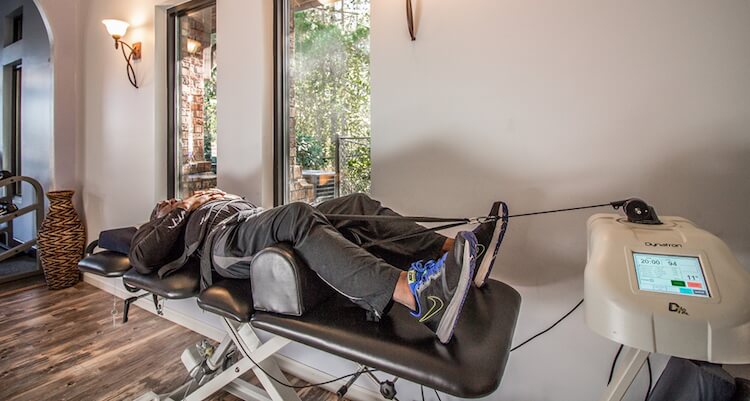Relieving Back Pain and Pressure
Spinal decompression at ProHeath Integrated is a non-invasive, non-surgical technology where a patient is placed onto an instrument which belts them in and relieves pressure from the spine. There are numerous factors which can sometimes trigger pressure and compression on the spinal column. It may be as a result of back injuries or intense physical activities, combined with gravity, which leads to the narrowing of the spinal channels and can cause hernias or sciatica after some time. This issue of compression of the channels is referred to as spinal stenosis and this health problem will cause bulging of the discs, agonizing pain, and other problems.
Spinal decompression therapy is valuable in figuring out the exact problems that can cause back pain and helps in dealing with the real point of need. Compression of the spine can result in cutting off the blood flow and nutrients among the vertebrae. This then leads to damage and degeneration in addition to the pain that an individual endures in his or her back. This spinal decompression technique allows for pressure to be relieved on certain joints and structures in either the lumbar or cervical regions of the spine. The treatment lasts about 15 to 20 minutes, depending on the type of device being used.
Definition
Spinal decompression is a term that describes the relief of pressure on one or many pinched nerves, also known as neural impingement of the spinal column.
There are both surgical and non-surgical methods used to treat conditions that result in chronic back pain such as disc bulge, herniation of a disc, spinal stenosis, sciatica, and spondyloisthesis.
Spinal Decompression Therapy
Candidates for spinal decompression therapy are patients that are usually suffering with a neck or low back pain issue. This treatment is typically for someone who has a long term condition lasting longer than 4 to 6 weeks, and has perhaps already seen a doctor or had an MRI. Patients who undergo this treatment are diagnosed with a herniated disc, degenerative disc problems, sciatica related to disc problems, or spinal stenosis.
Typical post-treatment experience for the patient is a little bit of soreness in the area of back pain. Around 15 to 20 minutes of stretching with spinal decompression is probably equivalent to working out in the gym for thirty minutes to an hour, for that specific area. Following treatment, the recommendation is to ice the area and rest for 20 minutes.
Generally speaking, spinal decompression is a linear force pulling on the body to create negative pressure between each vertebra. This negative pressure will cause a misaligned disc to be sucked back into place and create more space between the vertebrae so that more blood and oxygen can get to the area. It also will remove any pressure on spinal nerves because of the misalignment.
That’s the basic theory behind the techniques I’m going to outline for you. Each has its pros and cons, and none of them should be considered alone but rather as one part of a comprehensive back pain recovery program. A word of caution: The fact that a technique may have gotten approval from the Food and Drug Administration doesn’t necessarily mean it works better than any of the others – or is even worth trying.
Some conditions typically treated with spinal decompression include bulging or herniated discs, lumbar strains, sciatica, degenerative discs, spinal arthritis, degenerative joint disease, post-surgical low back pain, and acute back pain.
Let’s take a look at a few spinal decompression techniques, their effect on the body, and their intended outcomes.

The Missing Link: Spinal Decompression
We have covered various aspects of spinal decompression but know that by itself decompression may not give you the relief you desire, however, it is definitely a part of the treatment program for many patients we see.
The conditions aforementioned are from muscular imbalance and can bring on what is called “postural dysfunction. Postural dysfunctions force the pelvis into an abnormal position. As a result, the spine is forced into abnormal curvature, which over time causes abnormal wear and tear on the discs and vertebrae. This can lead to any number of painful conditions. There is no magical fix for muscle imbalance so it is important to realize that your recovery period will take time and is a process.
If you leave out any of the essential components, you are just wasting your time and money. The good news is that our bodies are very forgiving and extremely adaptive. Based on our habits, patterns, and posture, our muscles are being told throughout the day how they should act. If we have bad habits, patterns, and posture, our muscles will gradually get out of balance. If this continues long enough, we will start experiencing symptoms of one of the conditions we mentioned earlier.
A plan of action will include:
- An assessment needs to be done to see if your have any muscle imbalances or postural dysfunction.
- Second, you need a very precise, targeted stretching and exercise plan based on that assessment.
- Third, Depending how well an individual who follows the plan we layout is progressing it may become necessary to include a decompression therapy program.
When you come in for an appointment we’ll sit down and visit, at Pro Health Integrated it is the belief of Dr. Willis that patients who are well informed can make the best decisions for their individual care. Options do exist so by allowing us to educate you on these options the knowledge will empower you to feel comfortable with selecting the methods that best fit your lifestyle.


